The Benefits of Microgrid Fast Charging Stations: Powering the Future of Electric Mobility
This article explores the advantages of microgrid fast charging stations, their impact on the energy grid, and their role in promoting sustainable transportation.

As electric vehicles (EVs) continue to gain traction worldwide, the demand for efficient and reliable charging infrastructure is more critical than ever. One innovative solution that is making waves in the industry is the development of microgrid fast charging stations. These stations offer numerous benefits that address both current challenges and future needs in EV infrastructure. This article explores the advantages of microgrid fast charging stations, their impact on the energy grid, and their role in promoting sustainable transportation.
What are Microgrid Fast Charging Stations?
Microgrid fast charging stations are advanced charging systems that operate independently or semi-independently from the main power grid. They integrate renewable energy sources, such as solar or wind power, with energy storage systems (ESS) and advanced control technologies. This setup allows them to provide rapid charging for electric vehicles while maintaining stability and efficiency in the energy supply.
Key Benefits of Microgrid Fast Charging Stations
- Enhanced Reliability and Resilience
One of the primary advantages of microgrid fast charging stations is their ability to enhance the reliability and resilience of the charging network. By operating independently from the central grid, these stations can continue to function during power outages or grid failures. This reliability is crucial for EV users, particularly in emergency situations or in areas prone to grid instability.
Example: During natural disasters or grid failures, microgrid charging stations can provide a continuous power supply, ensuring that emergency services and critical infrastructure remain operational. This resilience is especially important for maintaining public safety and mobility during crises (IEA).
- Integration of Renewable Energy
Microgrid fast charging stations often incorporate renewable energy sources, such as solar panels or wind turbines, to generate electricity. This integration reduces the reliance on fossil fuels and decreases greenhouse gas emissions, contributing to environmental sustainability.
Example: A microgrid charging station equipped with solar panels can generate its own electricity during the day, storing excess energy in batteries for use at night or during peak demand periods. This not only reduces the carbon footprint but also promotes the use of clean energy in the transportation sector (Statzon - Market Insight Platform).
- Grid Stability and Peak Shaving
Microgrid systems can help stabilize the main power grid by managing energy loads and reducing peak demand. By storing energy during low-demand periods and discharging it during high-demand times, microgrids can alleviate stress on the central grid and improve overall efficiency.
Example: During peak hours, when electricity demand is highest, microgrid charging stations can use stored energy from batteries instead of drawing from the grid. This peak shaving capability helps prevent blackouts and reduces the need for expensive grid infrastructure upgrades (McKinsey & Company).
- Cost Savings and Economic Benefits
The ability to generate and store energy locally can lead to significant cost savings for both operators and consumers. Microgrid charging stations can reduce electricity costs by leveraging time-of-use pricing and avoiding high grid tariffs during peak periods. Additionally, they can provide economic benefits by creating jobs in the renewable energy and EV infrastructure sectors.
Example: By installing microgrid charging stations with solar panels, operators can lower their energy costs and pass these savings on to consumers through lower charging fees. This economic advantage can make EV ownership more affordable and attractive to a broader audience (Zap Map).
- Scalability and Flexibility
Microgrid fast charging stations are highly scalable and can be deployed in a variety of settings, from urban centers to remote rural areas. Their modular design allows for easy expansion as demand grows, and their ability to operate independently makes them ideal for locations with limited grid access.
Example: In remote or underserved areas where extending the central grid is cost-prohibitive, microgrid charging stations can provide a viable solution for EV charging. Their flexibility and scalability ensure that even the most isolated communities can benefit from electric mobility (Zap Map).
The Future of Microgrid Fast Charging Stations
The integration of microgrid technology in EV charging infrastructure is poised to play a crucial role in the transition to sustainable transportation. As the adoption of electric vehicles accelerates, the need for reliable, efficient, and environmentally friendly charging solutions will continue to grow.
Research and Development: Ongoing research and development efforts are focused on enhancing the efficiency and capabilities of microgrid systems. Innovations in energy storage, grid management, and renewable energy integration are expected to further improve the performance and affordability of microgrid charging stations.
Policy and Incentives: Government policies and incentives will be instrumental in promoting the deployment of microgrid fast charging stations. Supportive regulations and financial incentives can accelerate the adoption of these technologies and ensure that the necessary infrastructure is in place to meet the growing demand for EV charging.
Global Adoption: As countries around the world strive to reduce carbon emissions and combat climate change, the adoption of microgrid fast charging stations is likely to expand globally. These systems offer a scalable and sustainable solution that can support the growth of electric mobility in diverse regions and climates.
Conclusion
Microgrid fast charging stations represent a transformative approach to EV infrastructure, offering numerous benefits that address current challenges and support future growth. By enhancing reliability, integrating renewable energy, stabilizing the grid, reducing costs, and providing scalable solutions, these advanced charging systems are paving the way for a cleaner, more sustainable transportation future. As technology continues to evolve and adoption increases, microgrid fast charging stations will play a vital role in powering the electric vehicle revolution.
For further information, you can refer to:





